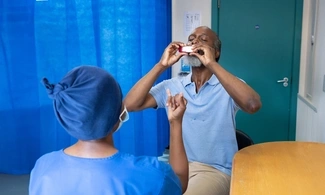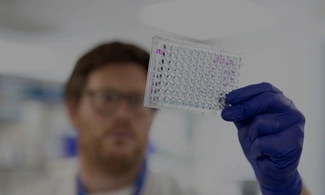Breathing problems in children can have a number of different causes. This page tells you what signs to look out for in your child and what they might mean.
Call 999 now if your child has any of these breathing-related symptoms:
- Your child is having severe difficulty breathing
- Your child is grunting with the effort of trying to breathe, their nostrils may flare in and out and they may be pursing their lips
- The muscles under their ribs are sucking in with each breath
- Fast breathing
- Your child won’t wake up, or won’t stay awake
- Your child’s breathing stops for 20 seconds or longer on one occasion, or there are regular shorter pauses in their breathing
- They have very pale or blue skin, or the inside of their lips and tongue are blue
- Fitting, if they have never had a fit before
Does your child have?
- a runny nose, blocked nose and sneezing
- a cough
- breathing problems
- a high temperature
- drowsiness (more sleepy than usual)
- problems with feeding and drinking
- aches and pains, sore throat, earache
- coloured phlegm (mucus)
- a change in skin colour
Runny nose, blocked nose and sneezing
A runny nose, blocked nose and sneezing are usually caused by a cold. If your child has a cold, they may also have a high temperature.
Sometimes it’s caused by an allergy – this is often called hay fever. Asthma is more common in children with allergy symptoms.
If your child’s runny or blocked nose, or their sneezing is caused by allergies, they may have problems sleeping too. It’s unusual to have a high temperature when a runny or blocked nose is caused by allergies.
If your child’s runny nose smells, or is bloody, there may be something in your child’s nose – you should seek medical advice.
Coughing
Everyone coughs from time to time. A cough helps clear the airway of mucus and things like dust and smoke. An occasional cough is not usually a sign of anything serious.
More persistent coughs can be because of a cold or viral infection that usually clears up in a few days. Some coughs carry on for a few weeks after the infection has cleared. Common cough medicines do not stop coughing and are not recommended for children. If your child is older than one year, you could give them honey to help soothe their throat. The NHS has advice on making a warm drink of honey and lemon.
Honey must not be given to infants under 12 months, as it can contain bacteria that might produce toxins in a baby’s intestines.
Occasionally, coughing can be a symptom of another condition that will need advice from a doctor. Seek help from your doctor if your child is coughing:
- and has a high temperature
- and wheezing (noisy breathing that sounds like high pitched whistling)
- and is having difficulty breathing, not able to do their usual activities, or isn’t eating or drinking normally and vomiting afterwards
- in periods that last over a minute several times a day, or
- for longer than three to four weeks.
It will help doctors and nurses if you can video the cough on your mobile phone. This is because different coughs are signs of different conditions:
- croup (barking cough)
- bronchiolitis (raspy and moist cough)
- whooping cough (bouts of coughing where your child may bring up mucus or vomit. They may gasp after coughing, or make a whooping noise)
- asthma (usually a dry cough). If your child has asthma they may cough more at night. Symptoms might also be brought on by hot or humid weather, cold or damp air, smoke, exercise, or emotions – read more about asthma triggers
- long term conditions like cystic fibrosis and primary ciliary dyskinesia (PCD) (constant wet or rattly cough)
Breathing problems
It’s important to seek help if your child is breathing differently than usual.
What do breathing difficulties look like?
- Breathing may be faster than usual or irregular
- Your child’s nostrils may flare (get wider) when they breathe
- They may wheeze when breathing out
- They may make a high-pitched sound when breathing in (stridor)
- They may make a grunting sound when breathing out - Call 999 if this happens
- The muscles under their ribs may suck in with each breath - Call 999 for urgent medical help.
Read more about when to call 999 about your child's breathing and when to go to the doctor.
Fast breathing
This can be a sign of an infection of the lungs, such as bronchiolitis or pneumonia. All children are different, and the main thing to watch out for is if your child is constantly breathing faster than usual, or is rapidly breathing, struggling with their breathing and panting.
Wheezing
Wheezing is a high-pitched whistling sound that comes from the chest, usually when your child is breathing out. If your child is well enough, a video on your mobile phone is a very helpful way of showing the nurse or doctor what’s happening. Wheezing is a common symptom of asthma.
Breathlessness or difficulty breathing
If your child is breathless or has difficulty breathing that becomes worse over a few hours, it could be a sign of an asthma attack. However, wheezing can have many causes, so it doesn’t always mean your child has asthma.
Remember: always seek urgent medical advice if your child is having difficulty breathing.
Pneumonia and chest infections can also cause breathlessness and fast breathing. Children usually have a fever with these conditions.
Difficulty breathing during exercise can be a sign of asthma. Talk to your child’s GP if you think your child may have asthma.
Sudden and unexpected breathlessness
If your child has sudden or unexpected breathlessness, or difficulty in breathing, it could mean they have something blocking their airway (breathing pipe) and are choking.
The NHS has guidance on stopping a child from choking. If your child is choking, call 999.
High temperature
A fever is a high temperature. In children, a temperature of 38C and over (100.4F) is considered high. If your child has a high temperature, they might:
- feel hotter than usual on their back or chest
- feel sweaty
- look or feel unwell.
You can check their temperature using a digital thermometer.
What’s causing my child’s fever?
A high temperature can be a sign of infection – including infections in the upper respiratory tract (ears, or nose or throat such as with a cold) and lungs (chest infection). Fever helps children and adults to fight infection.
Your child’s fever could also be caused by other illnesses or by routine vaccinations.
In itself, a fever is not dangerous. It is the cause of the fever that is the concern. Always seek medical advice if you are worried.
Treating a fever at home
If your child has a high temperature, you can usually look after them at home. It should go down over three or four days. Make sure you:
- give them plenty of fluids and watch out for signs of dehydration – these are seeming drowsy, having few or no tears when they cry, having a dry mouth, having dark yellow pee or if they haven’t peed in the last 12 hours
- give them food if they want it
- keep them at home if they go to nursery or school
- give them paracetamol if they’re feeling unwell (ask a pharmacist if you’re not sure what to give your baby or child)
- know when to seek medical help
Keep your child in light cotton clothing and in a cool room. It’s important you do not completely undress your child or try sponging them down with cold water to cool them down. This will cool their skin and make them shiver, and this can make their temperature rise even higher. You also should not cover them up in too many clothes or too much bedding.
NHS advice on fever
The NHS website has more information on high temperature and fever. You should seek urgent help if your child:
- is under three months and has a temperature of 38C (101F) or over
- is 3-6 months old and has a temperature of 39C (102F) or over.
Contact your GP for an urgent appointment. Out of hours, call NHS 111 (in England and Scotland), NHS 111 Wales or 0845 46 47 (in Wales) or your local out-of-hours service in Northern Ireland.
The NHS also suggests you should always get medical help for your child of any age who has a high temperature if:
- you think your child may be dehydrated
- your child develops a red rash that doesn’t fade when a glass is rolled over it
- your child has a fit
- your child doesn’t stop crying
- the fever lasts for more than five days
- your child’s health is getting worse
- you’re concerned about looking after your child at home.
Drowsiness
If your child has a high temperature (fever) they may also be drowsy or confused.
Children with a high temperature often lack interest or are more sleepy or irritable than usual. They usually improve after taking children’s paracetamol or ibuprofen to bring their temperature down. If you’re not sure what medicine to give your child, talk to a pharmacist.
Seek urgent help from your GP or health visitor if your child is drowsy and:
- has symptoms of breathing difficulty
- doesn’t improve after taking paracetamol or ibuprofen.
Out of hours, call NHS 111 (in England and Scotland), NHS 111 Wales or 0845 46 47 (in Wales) or your local out-of-hours service in Northern Ireland.
Call 999 if you're unable to wake your child or, if woken up, they are very drowsy and don't stay awake.
Problems with feeding and drinking
Problems with feeding and drinking can be a sign of a problem with the lungs and airways.
Your child may not be feeding or drinking well if:
- they have an infection and a high temperature
- they are struggling to feed and breathe at the same time.
Seek help if your baby is having difficulty breastfeeding (around a half to three quarters less than they normally would) or having dry nappies for 12 hours or longer.
You should seek urgent help if your child is showing signs of dehydration. These could be seeming drowsy, having few or no tears when they cry, having a dry mouth, having dark yellow pee or if they haven’t peed in the last 12 hours. They may need to go to hospital to make sure they get enough fluids.
Aches and pains
Chest pain, headaches and other aches and pains can be symptoms of a chest infection.
A tight, sore chest can also be a sign of asthma.
Babies and small children don’t usually complain about aches and pains. But they might be irritable if you pick them up.
If your child is older, they might say, ‘My chest’s hurting’ or ‘I’ve got a tummy ache’. Younger children might rub their tummy as well.
Talk to a doctor, nurse, or pharmacist for advice on how to treat aches and pains in your child.
Coloured mucus
Mucus (phlegm) protects your child’s airways. It traps dust and germs and carries them out of their lungs.
Mucus can be a problem if it doesn’t work properly or if there’s too much of it. A build-up of mucus in your child’s airways is called catarrh.
Young children usually swallow their mucus so you may not know what colour it is.
But if you are able to see it, yellow, green or brown mucus is a sign of infection or allergy. It might not be serious or need treatment. For example, green mucus running from their nose can be caused by mild infections that don’t need antibiotics.
Talk to your child’s doctor if you’re concerned about the colour of their mucus, or if you think there’s too much of it.
A change in skin colour
A change in your child’s skin colour may mean they do not have enough oxygen in their blood or their circulation is poor.
Call 999 now if:
- your child’s skin is very pale and they have other symptoms of an infection or difficulty breathing
- your child’s skin looks blue
- the inside of their lips and tongue are blue.
Next: information on respiratory tract infections
This content is currently being reviewed. Updated information will be available soon.








